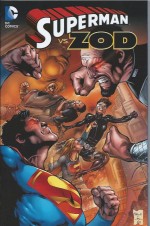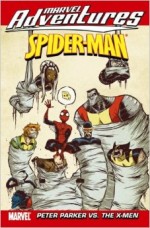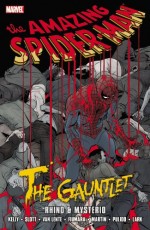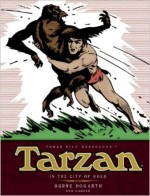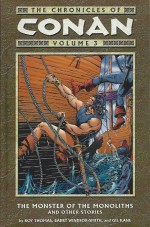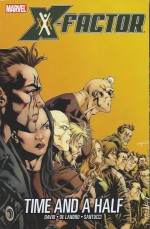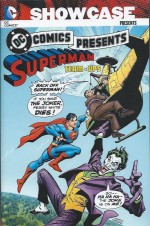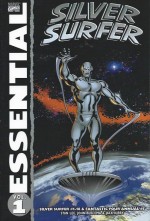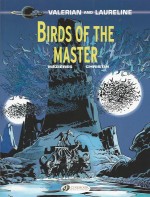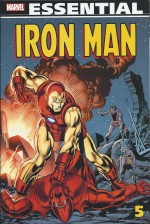
By Mike Friedrich, Bill Mantlo, Len Wein, Roger Slifer, Steve Gerber, P. Craig Russell, George Tuska, Arvell Jones, Keith Pollard, Chic Stone, Herb Trimpe, Sal Buscema & various (Marvel)
ISBN: 978-0-7851-6733-4
Arch-technocrat and supreme survivor Tony Stark has changed his profile many times since his debut in Tales of Suspense #39 (March 1963) when, whilst a VIP visitor in Vietnam observing the efficacy of the munitions he had designed, he was critically wounded and captured by sinister, savage Communists.
Put to work building weapons with the dubious promise of medical assistance on completion, Stark instead created the first Iron Man suit to keep himself alive and deliver him from his oppressors. From there it was a simple jump to full time superheroics as a modern Knight in Shining Armour…
Conceived in the wake of the Cuban Missile Crisis at a time when the economy was booming and “Commie-bashing†was America’s favourite national pastime, the emergence of a suave, gleaming new Edison, using Yankee ingenuity, wealth and invention to safeguard the Land of the Free and better the World, seemed an obvious development.
Combining the then-sacrosanct tenet that technology and business in unison could solve any problem with the universal imagery of noble paladins battling evil, the Invincible Iron Man seemed an infallibly successful proposition.
Whilst Stark was the acceptable face of 1960s Capitalism – a celebrity millionaire industrialist/scientist and alternatively a benevolent all-conquering hero when clad in the super-scientific armour of his secret alter-ego – the turbulent tone of the 1970s quickly relegated Iron Man’s rather unctuous, “can-do†image to the dustbin of history and, with ecological disaster and social catastrophe from the myriad abuses of big business forming the new zeitgeists of the young, the Golden Avenger and Stark International were soon confronting some tricky questions from the increasingly politically savvy readership.
With glamour, money and fancy gadgetry not quite so cool anymore the questing voices of a new generation of writers began posing uncomfortable questions in the pages of a series that was once the bastion of militarised America …
This sixth mammoth monochrome compilation covers another new start and change of direction for the Steely Centurion out of that transitional period, reprinting Iron Man #62-75, 77-87 and Annual #3 (September 1973 to June 1976): a period when the title experienced an unprecedented and often uncomfortable number of creative personnel changes even as the nation suffered radical and divisive schisms of ideology, an energy crisis and disco…
With Mike Friedrich scripting, the action opens in Detroit where Stark is inspecting one of his factories until former Maggia assassin ‘Whiplash Returns!’ (art by P. Craig Russell, Mike Esposito, Frank Giacoia & John Romita Sr.), raging for revenge and especially ticked off that his girlfriend has been made his boss, after which an extended epic began in #63 with ‘Enter: Dr. Spectrum’, illustrated by George Tuska & Esposito.
Here, as Tony Stark relentlessly – and fruitlessly – romantically pursues pacifist dissident Roxie Gilbert in Detroit, obnoxious Ugandan financier and diplomat Dr. Kinji Obatu visited the Long Island plant and was attacked by a gang of masked thugs.
The assault was repelled thanks to the timely assistance of stand-in Iron Man Eddie March, who was promptly offered a bodyguard job by the creepy ambassador and invited to accompany him to a meeting with Stark in “Motor Cityâ€.
No sooner did they arrive however than photonic fiend Dr. Spectrum ambushed the inventor, only to be driven off by the Armoured Avenger after a titanic and costly struggle. A far more serious problem emerged later when old friend Happy Hogan accused Tony of having an affair with his wife Pepper…
Spectrum struck again in the next issue, with a similar lack of success, before Happy blew his top and took a swing at Stark, but that confrontation was curtailed when a gigantic monster kidnapped the just-arrived Obatu in ‘Rokk Cometh!’
When the beast targeted Roxie, the exhausted Iron Man intervened but was too drained to resist the relentless Spectrum…
Issue #65 revealed ‘The Cutting Edge of Death!’ when the Golden Avenger learned the true parasitical nature of Spectrum’s Power Prism as it transferred itself from the wilfully disobedient villain Obatu to the worn-out hero. Its glee was short lived though as the possessed Iron Man was challenged by recently arrived comrade the Mighty Thor, resulting in a blockbusting ‘Battle Royal!’ which only ended after the Thunderer crushed the crystal conqueror to discovered the dying man inside the armour was neither Tony Stark nor Obatu…
As a consequence of that climactic clash of myth and mechanism, IM #67 saw the impostor Iron Man temporarily mutated by Stark’s medical miracle machine the Cobalt Enervator into a rampaging monster in ‘Return of the Freak!’ but no sooner had the real Armoured Avenger and surgeon Don Blake (who we all know was Thor back then) stopped and saved the berserk victim than Stark was drawn into another conflict in South East Asia…
Iron Man #68-71 (June to November 1974) was the opening sortie in a multi-part epic which saw mystic menace The Black Lama foment a war amongst the world’s greatest villains with ultimate power, inner peace and a magical Golden Globe as the promised prizes.
Written by Mike Friedrich and illustrated by Tuska & Mike Esposito, it began in Vietnam on the ‘Night of the Rising Sun!’ where the Mandarin struggled to free his consciousness, currently trapped within the dying body of Russian super-villain the Unicorn.
Roxie had dragged Stark to the recently “liberated†People’s Republic in search of Eddie March’s lost brother Marty, a POW missing since the last days of the war. Before long however the Americans were separated when Japanese ultra-nationalist, ambulatory atomic inferno and sometime X-Man Sunfire was tricked into attacking the intrusive Yankee Imperialists.
The attack abruptly ended after Mandarin shanghaied the Solar Samurai and used his mutant energies to power a mind-transfer back into his own body and, reinstated in his original form, the Chinese Conqueror began his own campaign of combat in earnest, eager to regain his castle from rival oriental overlord The Yellow Claw.
Firstly, though, he had to crush Iron Man who had tracked him down and freed Sunfire in ‘Confrontation!’ That bombastic battle ended when the Golden Avenger was rendered unconscious and thrown into space…
‘Who Shall Stop… Ultimo?’ then found the reactivated giant robot-monster attacking the Mandarin’s castle as the sinister Celestial duelled the Claw to the death, with both Iron Man and Sunfire arriving too late and forced to mop up the sole survivor of the contest in ‘Battle: Tooth and Yellow Claw! (Confrontation Part 3)‘…
After all the Eastern Armageddon a change of pace was called for, so Stark took in the San Diego Comicon in #72’s ‘Convention of Fear!’ (by Friedrich, Tuska & Colletta from a plot by Barry Alfonso) only to find himself ambushed by fellow incognito attendees Whiplash, Man-Bull and The Melter who were made an offer they should have refused by the ubiquitous Black Lama…
Next issue the Super-Villain War kicked into high gear with ‘Turnabout: a Most Foul Play!’ (art by Arvell Jones, Keith Pollard & Jim Mooney and a premise by letterer Tom Orzechowski).
After Pepper, Happy and Tony buried the hatchet at Stark International’s Manila plant, Iron Man returned to Vietnam and a deadly clash with the Crimson Dynamo in a hidden high-tech jungle city which was subsequently razed to the ground by their explosive combat.
Iron Man #74’s ‘The MODOK Machine!’ (Jones, Pollard & Dick Ayers) brought the Black Lama’s contest to the fore as the Mad Thinker electronically overrode the Avenger’s armour and set helpless passenger Stark upon the malevolent master of AIM…
Without autonomy, the Golden Gladiator was easily overwhelmed and ‘Slave to the Power Imperious!’ (inked by Chic Stone) saw him dragged back to the Thinker’s lair and laid low by a strange psychic episode even as MODOK finished his foe and apparently turned the still-enslaved steel-shod hero on his next opponent… the Yellow Claw.
Whilst this was happening, elsewhere radical terrorist Firebrand was somehow sharing Stark’s Black Lama-inspired “psycho-feedback†episodes…
The tale ended on a twisty cliffhanger as the Claw destroyed MODOK and his clockwork puppet Avenger, only to discover that the Thinker was not only still alive but still held the real Iron Man captive.
That was quite unfortunate as the following issue – #76 – blew its deadline and had to reprint Iron Man #9 (represented here by just the cover) before Friedrich, Jones & Stone’s ‘I Cry: Revenge!’ saw the fighting mad hero break free of the Thinker’s control, just as Black Lama teleported the Claw in to finish his final felonious opponent.
Still extremely ticked off, the Armoured Avenger took on all comers but was ambushed by the late arriving Firebrand who had been psionically drawn into the melee.
As Iron Man went down, the Lama declared non-contestant Firebrand the ultimate victor, explaining he had come from an alternate universe before duping the unstable and uncaring rabble-rouser into re-crossing the dimensional void with him…
Although a certifiable maniac and cold-blooded killer, Firebrand was also Roxie Gilbert’s brother and the groggily awakening Iron Man felt honour-bound to follow him through the rapidly closing portal to elsewhere…
The deadline problems persisted, however, and the next two issues were both hasty fill-in tales, beginning with #78’s ‘Long Time Gone’ by Bill Mantlo, Tuska & Vince Colletta which harked back to the Avenger’s early days and a mission during the Vietnam war which first brought home the cost in blood and misery that Stark’s munitions building had caused, whilst ‘Midnite on Murder Mountain!’ (scripted by Friedrich) saw the hero emphatically end the scientific abominations wrought by deranged geneticist and determined mind-swapper Professor Kurakill…
At last Iron Man #80 returned to the ongoing inter-dimensional saga as ‘Mission into Madness!’ by Friedrich, Chic Stone & Colletta, saw the multiversal voyagers arrive in a very different America where warring kingdoms and principalities jostled for prestige, position and power.
Here the Lama was revealed as King Jerald of Grand Rapids, a ruler under threat from outside invaders and insidious usurpers within. He’d come to Earth looking for powerful allies but had not realised that travel to other realms slowly drove non-indigenous residents completely crazy…
With the mind-warp effect already destabilising Iron Man and Firebrand, it was fortunate that treacherous Baroness Rockler made her move to kill the returned Jerald immediately, and the Earthlings were quickly embroiled in a cataclysmic ‘War of the Mind-Dragons!’ before turning on each other and fleeing the devastated kingdom for the less psychologically hazardous environs of their homeworld…
With the extended epic finally completed Mike Friedrich moved on, and Iron Man #82 welcomed a new era and tone as Len Wein, Herb Trimpe, Marie Severin & Jack Abel revamped the armour just in time for the Red Ghost and his super simians to kidnap super genius Tony Stark in ‘Plunder of the Apes!’
Debuting in that issue was NYPD detective Michael O’Brien, who held Tony responsible and accountable for the tragic death of his brother Kevin. The researcher had been Stark’s confidante until his mind snapped and he died wearing a prototype suit of Guardsman armour, but Mike smelled a cover-up…
IM #83 revealed ‘The Rage of the Red Ghost!’ (inked by Marie Severin) as the deranged Russian forced Stark to cure his gradual dispersal into his component atoms only to realise, following a bombastic battle, that the inventor had outwitted him yet again, after which Wein, Roger Slifer, Trimpe & John Tartaglione detailed how the Enervator again turned the grievously injured Happy into a mindless monster, but this time flooded him with so much Cobalt radiation that he became a ticking inhuman nuke on the ‘Night of the Walking Bomb!’
The tense tick-tock to doom was narrowly and spectacularly stopped in ‘…And the Freak Shall Inherit the Earth!’ (Slifer w/Wein, Trimpe, Severin) after which Mantlo, Tuska & Colletta revived and revamped one of the Golden Avenger’s oldest and least remembered rogues when disgraced thermal technologist Gregor Shapanka dumped his loser status as Jack Frost and attacked Stark International in a deadly new guise in # 86’s ‘The Gentleman’s Name is Blizzard!’
Despite his improved image the sub-zero zealot couldn’t quite close ‘The Icy Hand of Death!’, leaving this cracking chronicle to conclude with Iron Man Annual #3 (June 1976) and ‘More or Less… the Return of the Molecule Man!’ by Steve Gerber, Sal Buscema & Abel.
Whilst Tony Stark looked into developing some soggy Florida real estate,  a little girl found a strange wand and was possessed and transformed by the consciousness of one of the most powerful creatures in existence…
Although Iron Man was helpless to combat the reality-warping attacks of the combination petulant girl/narcissistic maniac, luckily for the universe, the shambling elemental shocker dubbed Man-Thing had no mind to mess with or conscience to trouble…
Finally closing the cover on this stellar compilation is a short cover gallery from the all-reprint Iron Man Annual #1 and 2 and Giant-Size Iron Man #1.
With this volume Marvel completely entrenched itself in the camp of the young and the restless who experienced at first hand and every day the social upheaval America was undergoing.
Their rebellious teen sensibility and increased political conscience permeated the company’s publications as their core audience moved beyond Flower Power protests towards a generation of acutely aware activists. Future tales would increasingly bring reformed capitalist Stark into many unexpected and outrageous situations…
But that’s the meat of another review, as this engrossing graphic novel is done. From our distant vantage point the polemical energy and impact might be dissipated, but the sheer quality of the comics and the cool thrill of the eternal aspiration of man in perfect partnership with magic metal remains.
These Fights ‘n’ Tights classics are amongst the most underrated but impressive tales of the period and are well worth your time, consideration and cold hard cash…
© 1973, 1974, 1974, 1976, 2013 Marvel Characters, Inc. All rights reserved.

